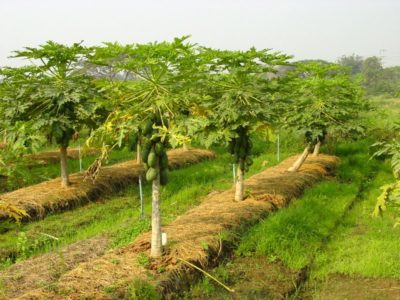
Papaya
The papaya (or Pawpaw) originates from Mexico, Central America and Northern South America, but is now grown in most tropical regions of the world.
Papaya is one of the most important tropical fruits in the world. The fruits are eaten fresh often at breakfast or as a dessert.
Names
Scientific
Carica papaya
English
Papaw
Papaya
Pawpaw
Tree melon
Dutch
Boommeloen
Meloenboom
Papaja
Papajaboom
Spanish
Fruta bomb
Lechosa
Mamón
Melón de árbol
Papaya
Papayo
French
Papaye
Papayer
German
Melonenbaum
Papaya
Papayabaum
Italian
Papaia
Taxonomy
Order
Brassicales
Family
Caricaceae
Genus
Carica
Species
Carica papaya (Papaya)
Basic information and facts
Origin:
Southern Mexico, Central America, Northern South America
Distribution:
Most tropical countries
Evergreen or deciduous:
Evergreen
Flowers:
Papaya has pleasant smelling flowers with five cream-white to yellow-orange petals of 2 to 5 cm length. The stigmatic surfaces are pale green in color. The stamens are bright yellow.
Leaves:
The spirally arranged leaves are on the top of the trunk. The lower part of the trunk shows the scars from earlier leaves and fruits. The large leaves are about 50-70 cm in diameter, they are deeply lobed with 7 lobes.
Fruits:
The smooth skinned fruits vary a lot in size and shape, depending on the variety and type of plant (round, oval, pear-shaped, etc.). Fruits can be small ( afew hundred grams) to big (several kilos). Usually the fruits contain many seeds surrounded by the smooth yellow to orange-red flesh which usually has a sweet taste.
Climate and weather:
Papaya needs a warm tropical climate.
Pollination:
Based on flower type there are three types of papaya plants: female, hermaphrodite, and male. Hermaphrodite flowers are usually self-pollinating. Female flowers are probably pollinated by wind or by insects (thrips, moths). Hand pollination can be used for better fruit setting.
Height:
5 to 10 meter
Light:
Papayas need a lot of sunlight.
Type of soil:
Papayas prefer light, well-drained soils. They do not like very wet soil.
Spacing (close range)
1.5 meter
Spacing (wide range)
3 meter
Propagation:
Usually propagated by seed.
Insect pests:
Mealybugs, thrips, mites, white flies, fruit spotting bugs, fruit flies.
Diseases:
Virus diseases, mildew, anthracnose, root rot.
Harvesting:
Harvest by hand when most of the skin is yellow-green. Then keep the fruit for ripening at room temperature for several days. The fruit is ripe when it feels soft and its skin has attained an amber to orange color.
Uses:
Eat papaya as a fresh fruit. Peel the skin, then slice the content and remove the seeds. To enhance the taste squeeze some lemon juice over it. Papaya can be mixed in fruit salads.
Did you know that?
- Papaya contains a natural pain reliever.
- Papaya fruit is a good source of dietary fiber.
- Traditional healers in some countries use unripe papaya for
contraceptive purposes. - Papayas are used to prevent and cure acne.
Recipes
Papaya nice and easy
Instructions:
Squeeze a lime over freshly cut papayas. Eat it.
Cooked papaya
Instructions:
Pick the papaya partially ripe, still mostly green with a little yellow. Saute 1 chopped onion in olive oil until clear, add cut up papaya pieces and cook until soft. Add 1 can of lite coconut milk diluted with a little water if milk is too thick, spice with either cinnamon and ginger if you enjoy sweet flavor or with cumin, curry, and Thai spices if you prefer spicy flavor, simmer for 15-20 minutes and serve hot over rice. Cooking the papaya really takes the strong soapy flavor away that some papaya have.
Crop categories
Fruits
Major crops
Subtropical crops
Tropical crops
Pictures

Papaya

Papaya trees

Papaya flower and young fruits

Papaya fruits in Bangladesh

One thought on “Papaya”
Is there an inconsistency on how long it takes the fruit to ripen? I have a tree with the fruit six months old now and still growing and not looking like it is beginning to ripen.